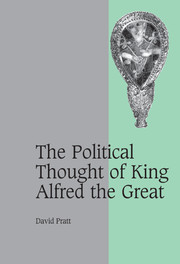Book contents
- Frontmatter
- Contents
- Acknowledgements
- List of abbreviations
- Note on citations
- Chapter 1 INTRODUCTION
- Part I The West Saxon Political Order
- Part II Alfredian Discourse and its Efficacy
- Chapter 7 THE FIELD OF ALFREDIAN KNOWLEDGE
- Chapter 8 THE CONSTRUCTION OF ALFREDIAN DISCOURSE
- Chapter 9 ALFREDIAN TECHNOLOGY: BOOKS AND ÆDIFICIA
- Chapter 10 THE HIERDEBOC AS A TREATISE OF POWER
- Chapter 11 THE DOMBOC AS A REORIENTATION OF ROYAL LAW
- Chapter 12 TRIBULATION AND TRIUMPH IN THE FIRST FIFTY PSALMS
- Chapter 13 THE SEARCH FOR A SATISFACTORY CONSOLATION
- Chapter 14 SEEING GOD AS HE IS
- Chapter 15 CONCLUSION
- Appendix: West Frankish deployment of Solomon's dream
- Bibliography
- Index of manuscripts
- General index
- Cambridge Studies in Medieval Life and Thought Fourth Series
Chapter 11 - THE DOMBOC AS A REORIENTATION OF ROYAL LAW
Published online by Cambridge University Press: 06 July 2009
- Frontmatter
- Contents
- Acknowledgements
- List of abbreviations
- Note on citations
- Chapter 1 INTRODUCTION
- Part I The West Saxon Political Order
- Part II Alfredian Discourse and its Efficacy
- Chapter 7 THE FIELD OF ALFREDIAN KNOWLEDGE
- Chapter 8 THE CONSTRUCTION OF ALFREDIAN DISCOURSE
- Chapter 9 ALFREDIAN TECHNOLOGY: BOOKS AND ÆDIFICIA
- Chapter 10 THE HIERDEBOC AS A TREATISE OF POWER
- Chapter 11 THE DOMBOC AS A REORIENTATION OF ROYAL LAW
- Chapter 12 TRIBULATION AND TRIUMPH IN THE FIRST FIFTY PSALMS
- Chapter 13 THE SEARCH FOR A SATISFACTORY CONSOLATION
- Chapter 14 SEEING GOD AS HE IS
- Chapter 15 CONCLUSION
- Appendix: West Frankish deployment of Solomon's dream
- Bibliography
- Index of manuscripts
- General index
- Cambridge Studies in Medieval Life and Thought Fourth Series
Summary
Often neglected, the law-book or Domboc gains much from approach within the broader structures of royal thought. Alfred's law-giving was a central act of Solomonic imitation, informed by biblical wisdom. A counterpart in many ways to the Hierdeboc, the Domboc fulfilled a similar function for secular office-holders as a defining text of ‘re-education’. The centrality of lordship matched shared interests in loyalty and common needs. As a guide to judgement, its contents echoed wider principles of probity and restraint. What distinguished law-giving was its combination of learned expertise with more immediate articulation of collective priorities. Yet the Domboc is not without difficulties as a tool of learning. One problem arises from its novelty in a field otherwise represented by much earlier legal texts. This is compounded by the Domboc's character, sometimes seen as ‘disorganized’, and on any assessment problematic. A third factor is the question of Frankish influence, certainly detectable on many grounds, the precise implications of which remain uncertain. All these issues have been treated at length by Wormald, yielding much on the text's legal import, yet in work often insistently committed to a particular view of early medieval law. Necessarily engaging with his findings and broader assumptions, what follows offers an alternative perspective on the Domboc's learned treatment of law and judgement.
WRITTEN LAW: AUTHORITY AND STATUS
In scale and structure, Alfred's Domboc had high ambitions. Like the Hierdeboc, its transmission was consistent. All six surviving manuscripts probably once included the Domboc in the same basic ‘edition’.
- Type
- Chapter
- Information
- The Political Thought of King Alfred the Great , pp. 214 - 241Publisher: Cambridge University PressPrint publication year: 2007
- 1
- Cited by



